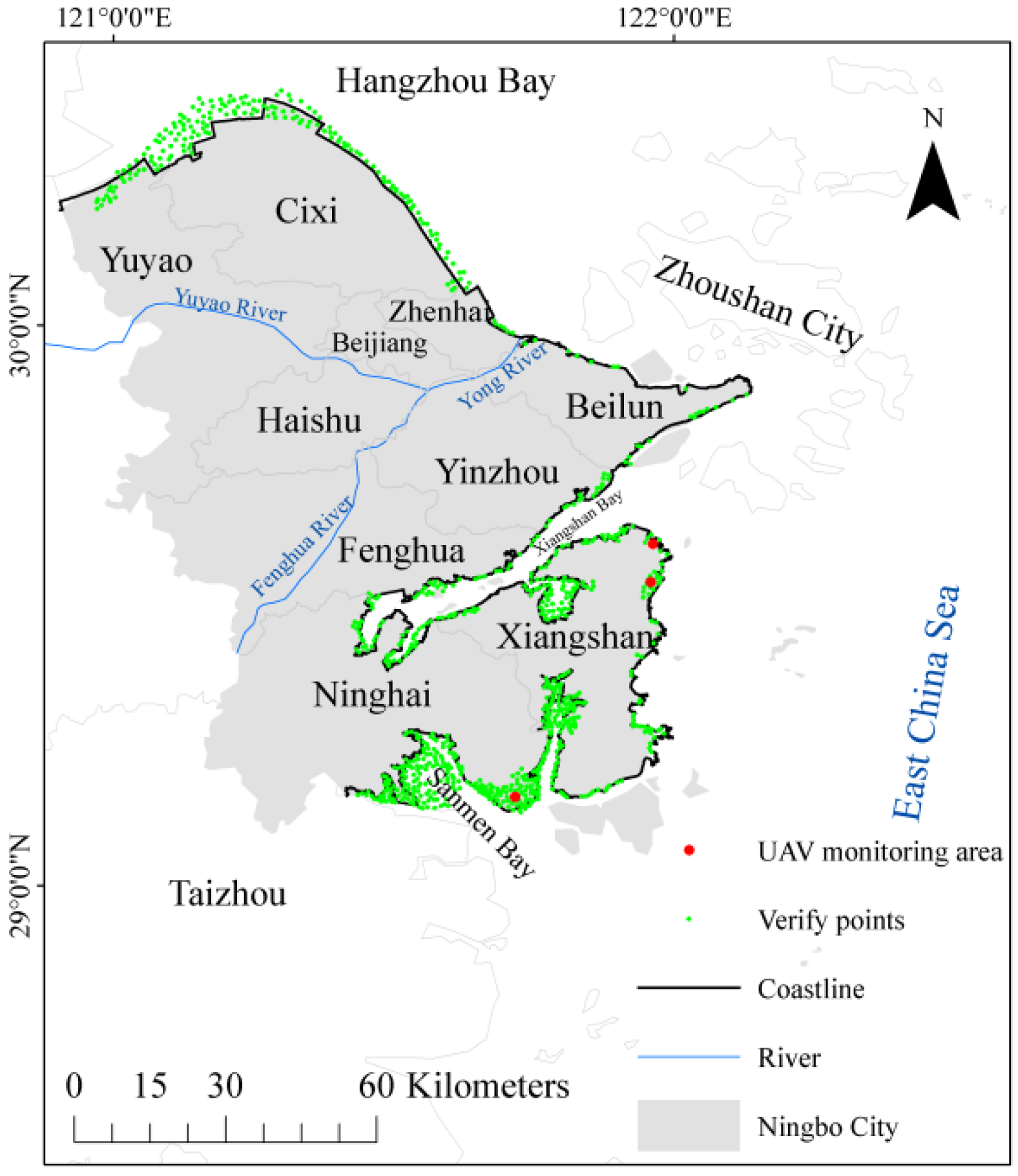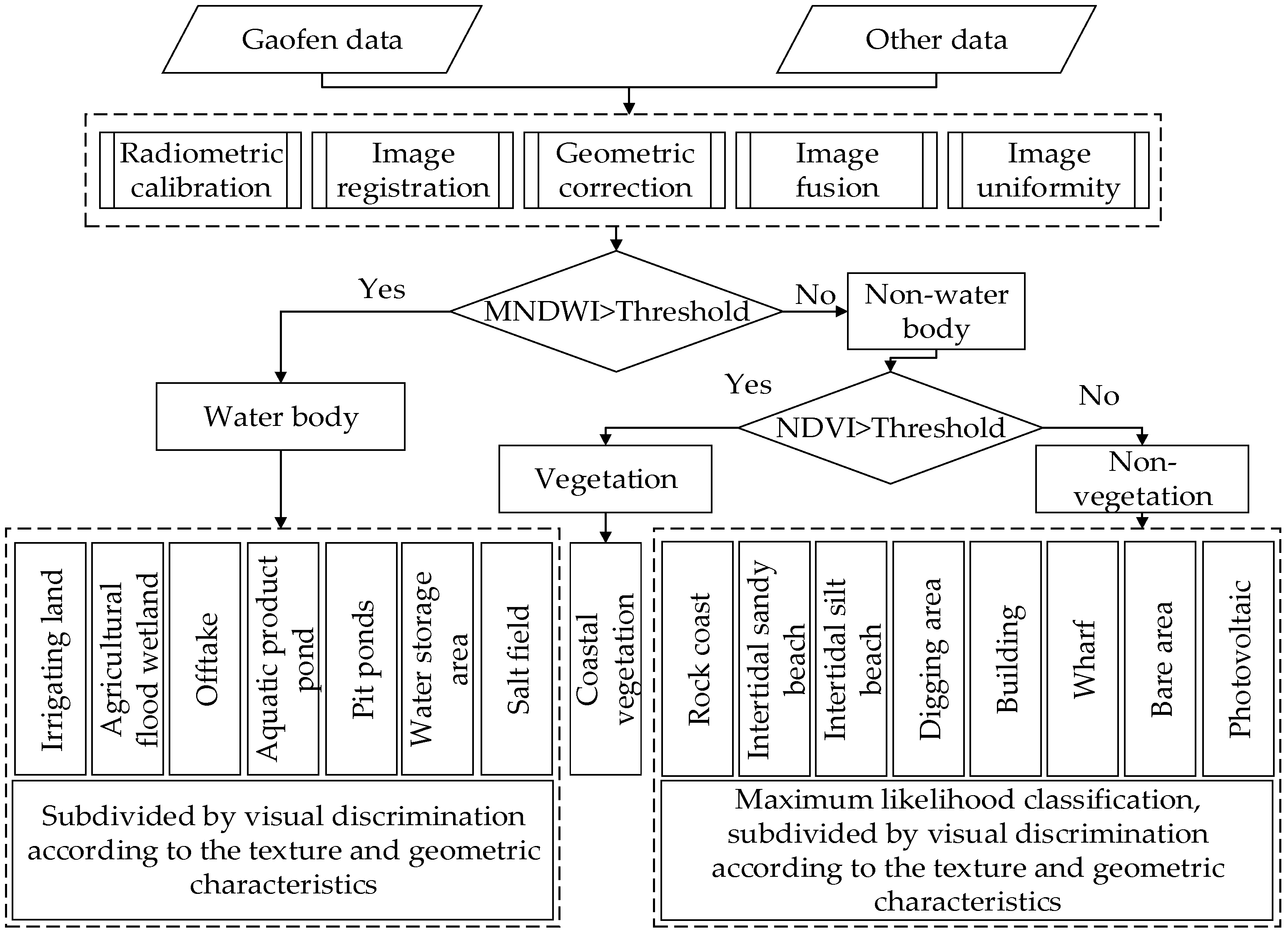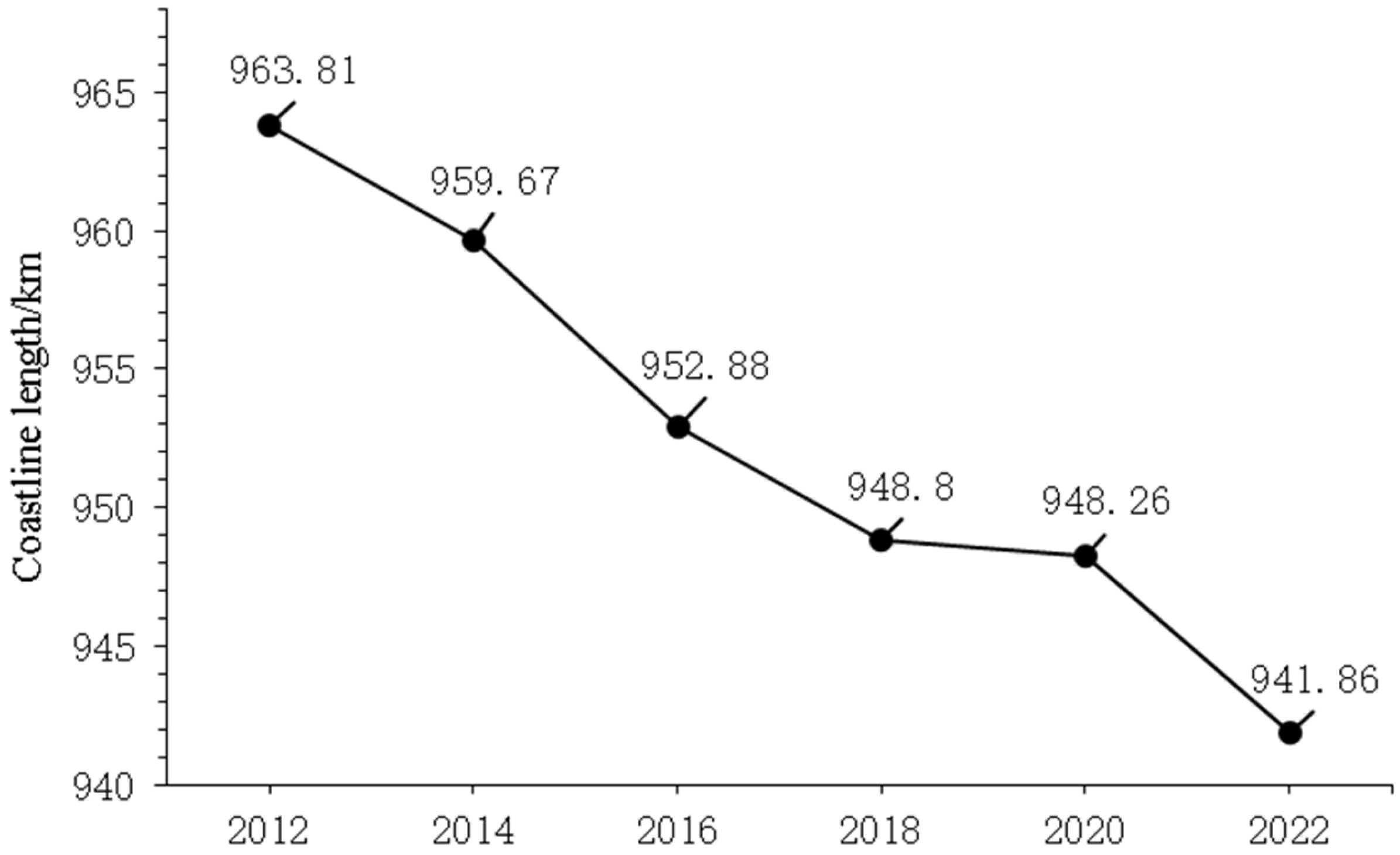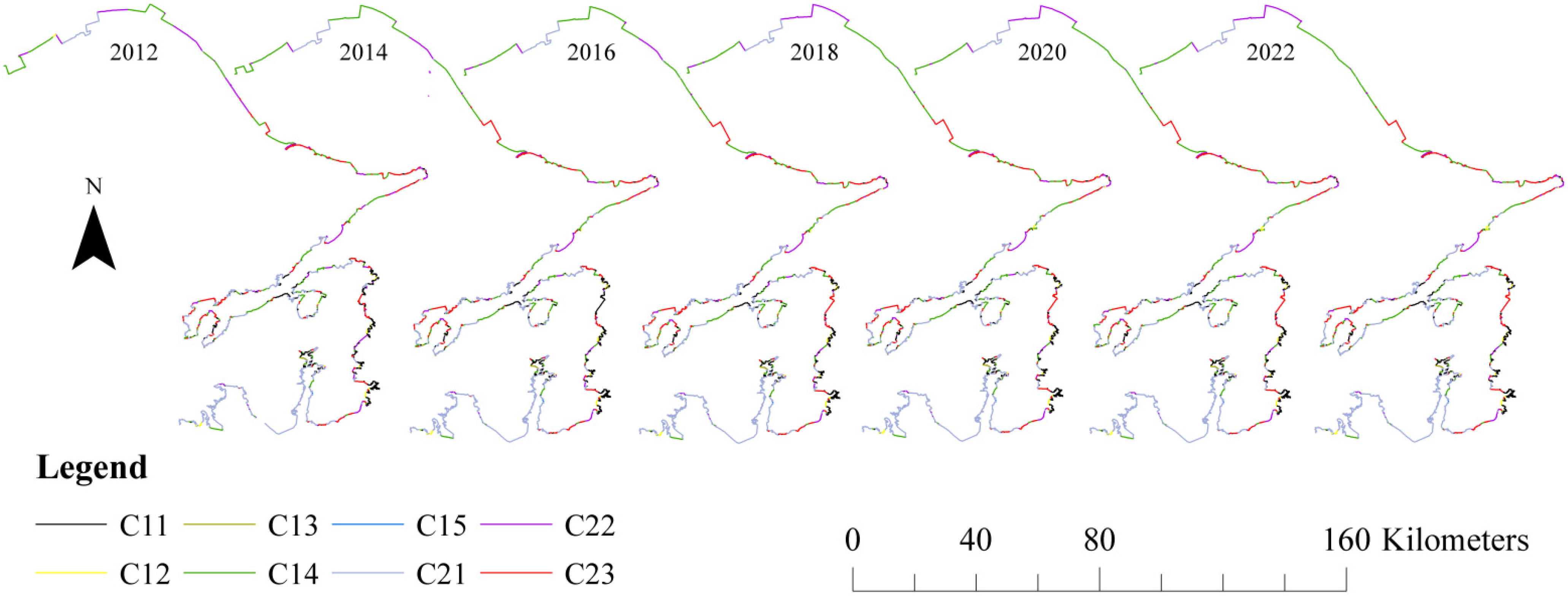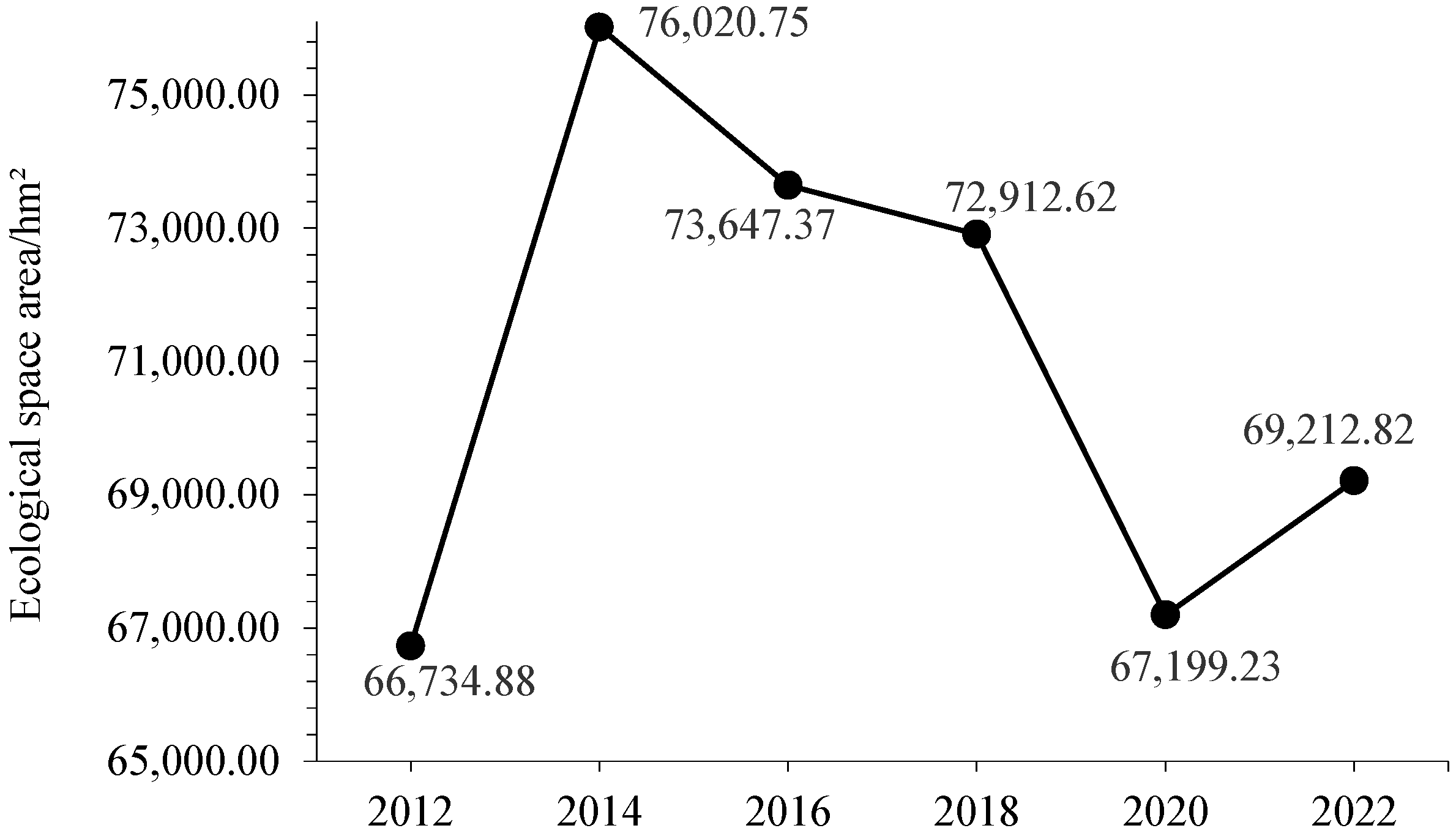4.2. Correlation Analysis Between Coastline Change and Coastal Ecological Space
To reflect the overall changes in ecological space, the area of coastal ecological space around Ningbo from 2012 to 2022 was calculated, and the area change curve was obtained (
Figure 7).
The coastal ecological space area in the study area began to decline continuously after the rapid growth in 2014, bottoming out around 2020 before starting to grow again (
Figure 7). To better illustrate the changing trend of different categories of ecological space, the coastal ecological space area is counted according to the attributes of different categories, see
Table 7. Additionally, in order to reflect the linkage relationship between coastal changes and coastal ecological space types, the long time-series overlap analysis of coastline and coastal ecological space was conducted, as shown in
Figure 8.
The ecological space area of the natural wetland in the study area is obviously larger than that of the artificial wetland, accounting for about 60% of the total ecological space area of the study area (
Table 7). It is not consistent with the proportion of coastline types. After overlapping analysis, it is found that the development of coastal ecological space on the land side by humans led to the change in coastline types, and the natural ecological space on the seaside cannot represent the coastline type. In terms of change, except for rocky coasts and docks, other types of ecological space have varying degrees of change. This is because the rocky coast is composed of hard rocks [
33]. Without the development of large engineering projects, it is not easy to change under the influence of seawater erosion, climate change, human activities and other factors, while other ecological spaces easily produce larger changes under the influence of different factors [
39].
(1) Analysis of the correlation factors of bedrock and wharf coastline change
Due to the minimal alterations observed in rocky shores and wharves, the corresponding coastline types (bedrock coastline and industrial wharf coastline) underwent relatively insignificant changes. Based on the analysis of coastline changes in Xiangshan County, it is evident that variations in bedrock and wharf coastlines are predominantly driven by human activities, with natural environmental factors contributing only marginally to these changes.
(2) Analysis of the correlation factors of sandy coastline change
From 2014 to 2016, the intertidal sand beach exhibited a trend of stabilization following a minor expansion. This expansion primarily occurred at the artificial beach within the Yangsha Mountain Tourism Resort in Chunxiao Town (
Figure 8). The additional beach area mainly resulted from the conversion of intertidal silt beaches, a transformation driven by the development and construction of the beach tourism zone as part of the resort’s overall planning [
37]. Such coastal modifications, which lead to changes in coastline types, are predominantly influenced by human activities, particularly government-led tourism area development planning. Within a short temporal framework, the likelihood of significant natural beach formation through weathering or wave action is relatively low.
(3) Analysis of the correlation factors of silt coastline change
The intertidal silt beaches experienced a slight reduction followed by stabilization during 2016–2018, with minimal area fluctuations. Significant spatial transformations were observed in the coastal zones of Yuyao City, Cixi City, and Zhenhai District (
Figure 8), primarily driven by the extensive colonization of
Spartina alterniflora, which has substantially altered the ecological spatial patterns. Notably, in 2018, the southeastern coastal region of Cixi City witnessed substantial encroachment of its intertidal silt beaches by
Spartina alterniflora. In contrast, the bay areas of Ninghai County and Xiangshan County maintained relative stability. The southwestern sector of Zhangshu Fishery Village underwent notable transformations due to the expansion of adjacent pond aquaculture operations, resulting in the conversion of beach areas into aquaculture zones and water storage facilities post-2016. Concurrently, the northwestern coastal region of Yuyao City experienced minor spatial modifications in its intertidal silt beaches, primarily attributable to the expansion of irrigation land. These silt beaches predominantly occur in peripheral coastal zones adjacent to open waters, exhibiting limited correlation with coastline typology. The silt-dominated coastlines are principally confined to river estuaries and undevelopable silt beach areas, reflecting their specific geomorphological characteristics and developmental constraints.
(4) Analysis of the correlation factors of biological coastline change
Spartina alterniflora exhibited a substantial expansion from 2016 to 2018, with minor fluctuations observed in other years. Its distribution demonstrates a strong spatial correlation with silt beach areas (
Figure 8), predominantly occupying the landward side of these intertidal zones. Originally native to North America,
Spartina alterniflora was introduced in 1996 for coastal protection and land reclamation purposes. This species demonstrates remarkable adaptability to saline-alkali soil conditions and tidal inundation, enabling rapid colonization of shallow beach and tidal flat environments. Consequently, it has become the predominant driver of biological coastline modifications in the study area.
The biological coastal zone also encompasses naturally occurring forest areas, which have maintained relative stability over time. These forested areas are primarily influenced by anthropogenic factors, particularly government-led planning and management interventions, rather than natural processes.
(5) Analysis of the correlation factors of artificial coastline change
Irrigation land demonstrated a consistent, gradual decline throughout the study period, with a more pronounced reduction observed between 2018 and 2020. Agricultural flood wetlands exhibited a substantial decrease from 2014 to 2016, followed by a significant expansion and subsequent stabilization from 2016 to 2020. These two land use types frequently co-occur in spatial distribution (
Figure 8), sharing similar functional characteristics but differentiated primarily by water volume capacity. This distinction is largely influenced by the timing of image acquisition. Both ecological space types show strong spatial correspondence with transportation and fishery coastline distributions. Their transformation processes substantially influence the evolutionary patterns of fishery and transportation-related coastlines, playing a dominant role in shaping the dynamics of these coastal zones.
Offtake exhibited a sustained incremental growth pattern, demonstrating strong hydrological connectivity with inland river networks. These engineered drainage features predominantly occur within industrial-agricultural development zones, showing spatial correlation with transportation infrastructure and coastal engineering projects (
Figure 8). Specifically, the system channels inland river water through engineered conduits to establish interconnected drainage networks with marine environments. This engineered hydrological regulation effectively mitigates hydrodynamic impacts from unconstrained river flows on adjacent development zones, while simultaneously creating optimized water management conditions that facilitate coordinated regional planning implementation.
The aquatic product ponds maintained relative stability throughout the study period, exhibiting minor fluctuations in 2016 while remaining largely unchanged in other years. These ponds are spatially adjacent to irrigated lands and agricultural flood wetlands (
Figure 8), collectively driving the evolution of fishery coastlines.
Pit ponds experienced substantial expansion from 2016 to 2018 before stabilizing. These features are predominantly located within cultivated lands and aquaculture zones, serving essential water storage and supply functions (
Figure 8).
Salt fields demonstrated remarkable stability, with a modest increase observed from 2014 to 2016 followed by minimal changes. The salt industry’s relatively fixed operational requirements have primarily contributed to the formation of transportation and land construction engineering coastlines.
Water storage areas showed minor fluctuations around 2018 before stabilizing. These features are typically situated on the peripheries of urban areas, industrial zones, and agricultural lands (
Figure 8), primarily functioning for flood control and irrigation purposes. They represent significant contributors to industrial and land construction engineering coastlines.
Building areas underwent rapid expansion between 2014 and 2016 before stabilizing. In Yuyao City’s northeastern coastal region, numerous industrial parks were developed through land reclamation during 2014–2016 (
Figure 8), driving substantial area growth. Other regions predominantly consist of industrial zones, residential areas, and tourist resorts, serving as crucial generators of industrial, tourism, and land construction engineering coastlines.
(6) Other ecological spaces
The digging areas exhibited distinctive temporal patterns, initially emerging in 2016 and stabilizing after a minor decline in 2018. These areas demonstrate a dispersed spatial distribution pattern (
Figure 8) and represent transitional rather than permanent ecological spaces. Their formation and evolution are strongly influenced by anthropogenic activities, frequently co-occurring with irrigated lands or agricultural flood wetlands. As temporally intermittent spatial features, they maintain no significant association with the coastline.
Bare areas have shown gradual expansion since their initial appearance in 2014. These areas predominantly occupy underutilized zones, including decommissioned ports and abandoned industrial sites (
Figure 8). While spatially coexisting with various coastal ecological zones, their intermittent temporal characteristics preclude clear associations with specific coastline types.
Photovoltaic installations have experienced substantial growth since their introduction around 2016. Currently concentrated in the coastal regions of Cixi City, Ninghai County, and Xiangshan County (
Figure 8), their distribution reflects government planning initiatives. These installations are primarily located in inland coastal zones, showing no spatial correlation with specific coastline typologies.
